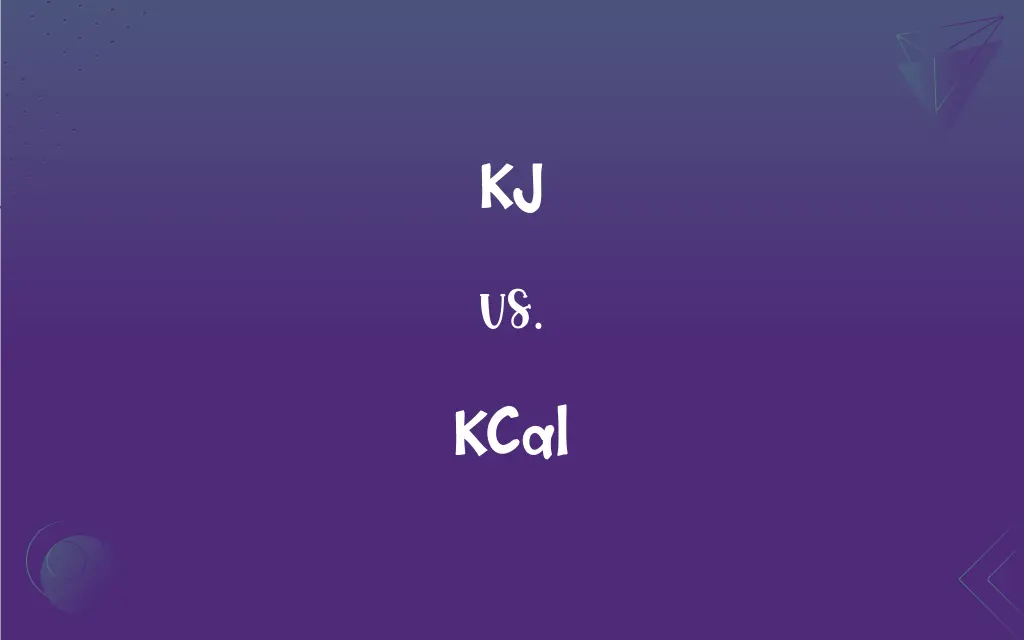KJ vs. KCal: What's the Difference?
Edited by Aimie Carlson || By Janet White || Published on February 25, 2024
kJ (kilojoules) and kcal (kilocalories) are units of energy, with 1 kcal equaling approximately 4.184 kJ.

Key Differences
kJ, or kilojoules, is a unit of energy in the International System of Units (SI), primarily used in scientific contexts and some nutrition labeling. kcal, short for kilocalories, is commonly used in dietary and food energy contexts, especially in the United States and some other countries.
Both kJ and kcal measure the same thing: energy. However, they belong to different measurement systems; kJ is part of the metric system, while kcal is part of the older imperial system.
The conversion factor between these two units is a key difference. One kilocalorie (kcal) is approximately equal to 4.184 kilojoules (kJ). This factor is essential when converting energy values in food from one system to the other.
In nutritional contexts, kJ and kcal are used to express the energy content of foods. Different countries prefer different units; for instance, European countries often use kJ, while the U.S. tends to use kcal.
In scientific research, kJ is more commonly used due to its alignment with the SI system. kcal, while still used, is more prevalent in specific fields like dietetics and food science.
ADVERTISEMENT
Comparison Chart
Measurement System
International System of Units (SI)
Imperial system
Common Usage
Scientific research, some nutrition labels
Dietary and food energy content
Conversion Factor
1 kJ = 0.239 kcal
1 kcal = 4.184 kJ
Nutritional Labeling Preference
More common in Europe and Australia
Predominantly used in the United States
Alignment with Systems
Metric system
Older imperial system
ADVERTISEMENT
KJ and KCal Definitions
KJ
KJ is used to measure both mechanical and thermal energy.
This machine's output is measured at 500 kJ.
KCal
Kcal is commonly used to express the energy content of foods in the U.S.
The nutrition label states that the yogurt has 150 kcal per serving.
KJ
Commonly used in scientific and technical fields.
The chemical reaction released 250 kJ of energy.
KCal
Kcal represents the amount of energy needed to raise the temperature of one kilogram of water by one degree Celsius.
The experiment calculated the energy released as 600 kcal.
KJ
A kilojoule is a thousand joules, used in energy calculations.
For this physics problem, we need to convert the energy to kJ.
KCal
In dietetics, kcal is used to measure food energy.
To lose weight, she is tracking her daily intake, aiming for 1,800 kcal.
KJ
A unit of energy in the metric system, equal to 1,000 joules.
The energy content of the snack bar is 950 kJ.
KCal
A unit of energy, equivalent to 1,000 calories, often used in dietary contexts.
This meal contains approximately 450 kcal.
KJ
In nutrition, kJ quantifies the energy value of food.
The label shows that 100 grams of this cereal provides 1,600 kJ.
KCal
A kilocalorie is often referred to as a calorie in casual dietary terms.
Each cookie has 100 kcal, which is commonly said as 100 calories.
KCal
Abbreviation of kilocalorie
FAQs
What does kcal represent?
kcal represents kilocalories.
Why do some countries use kJ over kcal?
Some countries prefer kJ as it aligns with the SI unit system.
Which is more commonly used in scientific research?
kJ is more commonly used in scientific research.
Why do American food labels use kcal?
kcal is traditionally used in the U.S. for dietary energy content.
Can you convert kJ to kcal easily?
Yes, by using the conversion factor of 1 kcal ≈ 4.184 kJ.
How many joules are in a kilojoule?
There are 1,000 joules in a kilojoule.
Which unit is larger, kJ or kcal?
kcal is larger, as 1 kcal equals approximately 4.184 kJ.
How is kJ used in energy expenditure?
kJ is used to quantify energy used in physical activities and metabolic processes.
What does kJ stand for?
kJ stands for kilojoules.
Is kcal the same as a calorie?
Yes, in dietary terms, 1 kcal is often referred to as 1 calorie.
What's the main difference between kJ and kcal?
The main difference is their measurement system: kJ is metric, while kcal is imperial.
Is kcal still relevant in nutrition?
Yes, kcal is widely used in nutrition, especially for food energy content.
Why is understanding kcal important for dieting?
Knowing kcal values helps manage energy intake for weight control.
How accurate are kJ and kcal measurements?
They are generally accurate but depend on the precision of measuring methods.
Are kJ and kcal used globally?
Yes, but their usage varies by region and field.
Are kJ and kcal interchangeable?
They can be converted, but they are different units of measurement.
How do nutritionists use kJ and kcal?
Nutritionists use these units to calculate and recommend energy intake.
How is kJ used in physics?
kJ is used to measure energy, work, or heat in physics.
Can kJ be converted to other energy units?
Yes, kJ can be converted to other units like watts or BTUs.
Is kcal used in food science?
Yes, kcal is widely used in food science for energy content analysis.
About Author
Written by
Janet WhiteJanet White has been an esteemed writer and blogger for Difference Wiki. Holding a Master's degree in Science and Medical Journalism from the prestigious Boston University, she has consistently demonstrated her expertise and passion for her field. When she's not immersed in her work, Janet relishes her time exercising, delving into a good book, and cherishing moments with friends and family.
Edited by
Aimie CarlsonAimie Carlson, holding a master's degree in English literature, is a fervent English language enthusiast. She lends her writing talents to Difference Wiki, a prominent website that specializes in comparisons, offering readers insightful analyses that both captivate and inform.































































